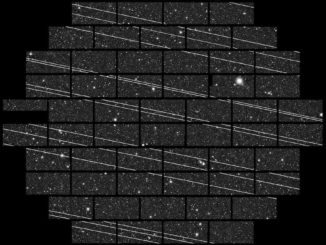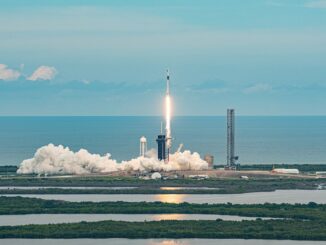
The launch of a Northrop Grumman Antares rocket with an automated commercial space station cargo vessel from Virginia was aborted less than three minutes before takeoff Sunday after engineers detected unusual readings from a ground support sensor. Northrop Grumman and NASA officials said the next launch attempt is scheduled for no earlier than Thursday.
The Antares launch team aborted Sunday’s countdown less than three minutes before liftoff from Wallops Island, Virginia, with nearly 4 tons of supplies and experiments for the International Space Station.
“LC (Launch Conductor, this is prop lead. Abort. Abort,” a member of the Antares team announced on the countdown net.
“Launch team, we have an abort,” said Adam Lewis, Northrop Grumman’s Antares launch conductor. “Time to proceed to abort safing checklist.”
The countdown abort occurred after teams earlier delayed the rocket’s target launch time by five minutes to 5:44 p.m. EST (2244 GMT), the end of Sunday’s five-minute launch window. The Antares rocket only had a short time Sunday to take off and reach the proper orbit for Northrop Grumman’s Cygnus supply ship to rendezvous with the International Space Station.
It was not immediately clear whether the reason for the earlier five-minute delay and the cause of the aborted countdown were related.
With no more time available in Sunday’s launch window, officials scrubbed the launch attempt.
Weather conditions on Virginia’s Eastern Shore are forecast to worsen Monday and remain unfavorable for a launch much of the week. Officials set a new target launch date for Thursday, Feb. 13, to wait for better weather and allow time for technicians to address the ground support issue.
A NASA spokesperson said Northrop Grumman, which owns and operates the Antares rocket and Cygnus spacecraft under contract to NASA, aborted Sunday’s countdown due to “off-nominal data from ground support equipment at the launch pad.”
NASA’s mission control team at the Johnson Space Center in Houston informed astronaut Drew Morgan on the space station that the Antares launch did not happen as planned Sunday. Mission control radioed Morgan that cause of the scrub was a “regulator issue” on the launch pad.
Northrop Grumman plans to lower the 139-foot-tall (42.5-meter) Antares rocket horizontal on launch pad 0A at Wallops Island to change out time-sensitive cargo inside the Cygnus spacecraft’s pressurized cabin. Ground crews loaded biological research specimens, fresh fruit and vegetables, and other perishable items into the Cygnus spacecraft Saturday night, less than 24 hours before mission was scheduled for launch.
Some items among the “late load” materials have a limited shelf life inside the Cygnus, and must be replaced during launch delays that last multiple days.
The Antares rocket is set to blast off with Northrop Grumman’s 13th resupply flight — designated NG-13 — to the International Space Station under a pair of multibillion-dollar commercial cargo transportation contracts with NASA.
NASA has similar commercial resupply contracts with SpaceX and Sierra Nevada Corp.
Northrop Grumman named the Cygnus spacecraft flying on the NG-13 mission the S.S. Robert H. Lawrence in honor of the first African American selected as an astronaut. Air Force Maj. Robert H. Lawrence was selected to train and fly on the U.S. military’s Manned Orbiting Laboratory, a spy station where military crews would have gather surveillance imagery of the Soviet Union and other strategic locations around the world.
But Lawrence died in an aircraft accident less than six months after his selection as an astronaut in 1967. The Manned Orbiting Laboratory was eventually cancelled before it ever flew in space, and the military astronauts training on the program were transferred to NASA, which assigned the test pilots fly on early missions of the space shuttle.
Assuming the launch occurs Thursday, the Cygnus spacecraft is scheduled to reach the space station Saturday, Feb. 15, to begin a stay lasting roughly three months.
At the end of the mission, the Cygnus freighter will depart the station and deploy CubeSats in orbit. Then the spacecraft will host a sophisticated large-scale combustion experiment to help scientists study how flames behave in microgravity, and under different atmospheric conditions.
Fire experiments of the scale to be performed inside the unpiloted Cygnus spacecraft are too dangerous for the International Space Station in close proximity to astronauts, scientists said.
Email the author.
Follow Stephen Clark on Twitter: @StephenClark1.



